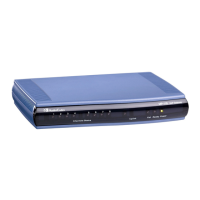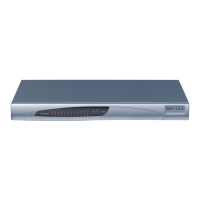used for FXS interfaces, where each endpoint registers
(and authenticates) separately with its user name and
password.
[1] Per Gateway = (Default) Single registration and
authentication for the entire device. This is typically used for
FXO interfaces.
[3] Per FXS = Registration and authentication for FXS
endpoints.
Web: Set Out-Of-Service On
Registration Failure
EMS: Set OOS On Registration Fail
[OOSOnRegistrationFail]
Enables setting the endpoint or entire device (i.e., all
endpoints) to out-of-service if registration fails.
[0] Disable (default)
[1] Enable
If the registration is per endpoint (i.e., AuthenticationMode is
set to 0) or per Account (see Configuring Hunt Group Settings
on page 204) and a specific endpoint/Account registration fails
(SIP 4xx or no response), then that endpoint is set to out-of-
service until a success response is received in a subsequent
registration request. When the registration is per the entire
device (i.e., AuthenticationMode is set to 1) and registration
fails, all endpoints are set to out-of-service.
Note: The out-of-service method is configured using the
FXSOOSBehavior parameter.
[UnregistrationMode]
Enables the device to perform explicit unregisters.
[0] Disable (default)
[1] Enable = The device sends an asterisk ("*") value in the
SIP Contact header, instructing the Registrar server to
remove all previous registration bindings. The device
removes SIP User Agent (UA) registration bindings in a
Registrar, according to RFC 3261. Registrations are soft
state and expire unless refreshed, but they can also be
explicitly removed. A client can attempt to influence the
expiration interval selected by the Registrar. A UA requests
the immediate removal of a binding by specifying an
expiration interval of "0" for that contact address in a
REGISTER request. UA's should support this mechanism
so that bindings can be removed before their expiration
interval has passed. Use of the "*" Contact header field
value allows a registering UA to remove all bindings
associated with an address-of-record (AOR) without
knowing their precise values.
Note: The REGISTER-
applies to all registrations, but it can only be used if the Expires
header field is present with a value of "0".
Web/EMS: Add Empty Authorization
Header
[EmptyAuthorizationHeader]
Enables the inclusion of the SIP Authorization header in initial
registration (REGISTER) requests sent by the device.
[0] Disable (default)
[1] Enable
The Authorization header carries the credentials of a user
agent (UA) in a request to a server. The sent REGISTER

